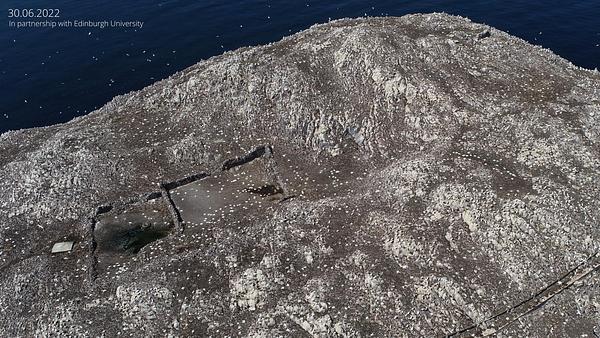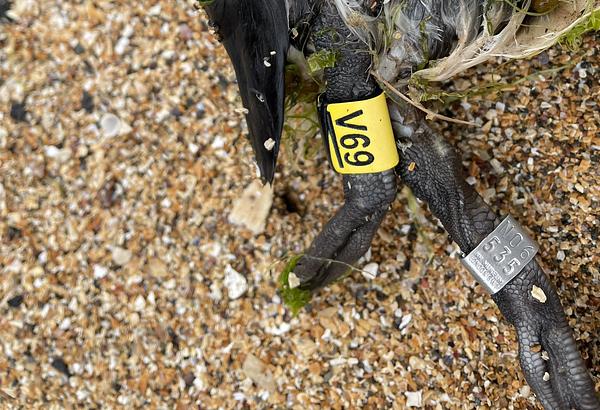_Emily_Burton_Header_Image.jpg)
Disease
AVIAN FLU IN SCOTLAND'S SEABIRD COLONIES [Updated 14 August 2023]
EMERGENCE OF AVIAN FLU
The first signs of Highly Pathogenic Avian Influenza (HPAI) in Scottish seabirds was detected in great skuas in colonies in Shetland, Orkney and St Kilda at the end of the 2021 breeding season; just before these seabirds migrated back to their over-wintering areas off the African coastline. The disease was subsequently detected at the start of the 2022 breeding season in Northern gannets on NatureScot's National Nature Reserves of Noss and Hermaness. Given the outbreak in the North of Scotland the level of surveillance immediately increased at seabird colonies around the UK.
In late May 2022 higher than usual numbers of Northern gannets were found washed up along the East Lothian shoreline causing much concern amongst the public and then, a few weeks later, dead gannets were also detected using the Scottish Seabird Centre's interactive wildlife cameras on the Bass Rock. Two of these dead birds were brought off the island for testing by Defra's laboratories, along with some birds from North Berwick beaches, and it was not long before the news came back that everyone had feared - HPAI (sub-type H5N1) was confirmed. This was a big blow!

ORIGINS OF AVIAN FLU
Whilst Low Pathogenic Avian Influenza (LPAI) has circulated in wild bird populations for many years, this deadly (highly pathogenic) strain is a relatively recent occurrence. It is reported to have come from intensive poultry settings in South-East Asia. The other notable recent occurrence of avian flu was in the winter of 2021 when thousands of Svalbard barnacle geese around the Solway Estuary in South-West Scotland died, resulting in an estimated 38% decrease in the flyway (migration route) population which was 39,700 birds in 2020/21.
SPECIES AFFECTED
Many seabird species have now tested positive for HPAI H5N1 and the number of species and sites has increased, with the disease circulating in the environment for the last three years. At the time of publication - August 2023 - the Scottish Government's Avian Flu Response Plan stated that 603 wild birds across 34 species and 153 locations in Scotland tested positive for HPAI between 1 October 2021 and 30 September 2022.
The numbers of dead birds recorded is however a signficant under respresentation of the total mortality due to the way in which data is collected and reported. The response plan does not capture the effects of the persistence of the disease over the winter and its re-emergence towards the end of the 2023 seabird breeding season when the disease took its toll on terns, guillemots, razorbills and kittiwakes. Within the first two weeks of cases being reported in these species in the summer of 2023 NatureScot recorded 1,443 dead guillemots, 1,570 dead black-legged kittiwakes and 236 dead herring gulls. That number continued to grow as the breeding season reached its end.
Similar scenes, as those experienced in 2022, developed again with dead birds washing up along our coastline. This again drew attention from national media sources; helping to raise overall awareness of the disease and its impacts.
_Susan_Davies_IMG_4797.JPG)
BASS ROCK - NORTHERN GANNETS
The full scale of the impact of avian flu on the Bass Rock Northern gannet colony has yet to be fully assessed. Thousands of gannets died in 2022 and as the disease hit the colony at the start of the breeding season the effect was severe with adult birds dying and nests, eggs and chicks being deserted or predated. This means far fewer young birds were recruited back into the population in 2023 and, as a long-lived species that does not breed until it is 4 years or older, it will take the colony several years to recover from this disease. You can find out more about the life-cyle of Northern gannets in our species profile or through our gannet life-cycle learning video resource.
As Scotland supports 56% of the global population of Northern gannets, and with the Bass Rock prior to avian flu hitting being acknowledged to be the largest colony in the world, the disease impacts will be seen at the global population level. IUCN (International Union for Nature Conservation) currently list Northern gannets as being of least conservation concern whilst the latest UK Birds of Conservation Concern 5 lists the species as amber rated.
BASS ROCK - COLONY COUNTS
A drone survey of the whole Bass Rock Northern gannet colony was flown at the end of June 2022 in collaboration with the University of Edinburgh - airbonre research and innovation department. This gave a very good visual image of the scale of the impact of the disease, with 5000 dead birds counted from the imagery captured during the single drone fly over. As the colony was so disrupted the images were not used to estimate the reduction in the colony size. Further drone surveys are planned in for summer 2023 and will be used to provide an assessment of how the colony has changed over this period and as a baseline for monitoring the colony's recovery.

BLACK EYES IN GANNETS - A SIGN OF SURVIVAL
A team of scientists led by RSPB Conservation Scientist - Dr Jude Lane - undertook a study on the Bass Rock in 2022 to gain further insights into the black and mottled irises – instead of the usual pale blue – that were being observed in Nothern gannets breeding on the Bass Rock. The research team took blood samples from 18 apparently healthy adult Northern gannets, those with both normal and black irises, and sent these to the Animal and Plant Health Agency for testing for the presence of avian flu antibodies. Eight tested positive, of which seven had black irises. The research team also calculated that adult survival between 2021 and 2022 was 42% lower than the preceding 10-year average within their study plot.
SURVEILLANCE AND RESEARCH
Monitoring of our seabird colonies is co-ordinated through the Seabird Monitoring Programme. Surveyors visit coastal and inland sites each year to count numbers of breeding seabirds (25 species) and, where possible, their chicks to monitor breeding success. The programme also forms the basis of a full census of seabird colonies that takes place every 20 years. The most recent results from the Seabird Monitoring Programe were published by the UK Joint Nature Conservation Committee (JNCC). Co-ordination of the programme recently (July 2022) transitioned from the JNCC to the British Trust for Ornithology (BTO).
Enhanced surveillance of our seabird colonies is required to assess the level of mortality and the rate of spread of avian flu, as well as further observations and research to learn more about how the disease presents itself clinically in wild birds. More science is required to better understand the pathways that HPAI spreads though and the biosecurity steps that can be taken to minimise spread in future. We welcomed the announcement by the UK Government of further research into the disease - Avian flu research consortium - and some of the research needs have also been captured in the Scottish Government's Avian Flu response plan, which was informed by NatureScot's Task Force.
GUIDANCE FOR LAND MANAGERS AND PUBLIC
Given the scale of the situation on the Bass Rock, the Scottish Seabird Centre took the decision to supsend all its specialist Bass Rock landing trips in 2022 and NatureScot followed suit announcing a little later its decision to close the Isle of May National Nature Reserve to visitors.
NatureScot published guidance for site managers advising people to avoid landing on some seabird islands until the end of the breeding season, in an effort to reduce disturbance and risks of spreading the disease further. Both islands were able to reopen for public landings at the start of the 2023 breeding season with enhanced biosecurity and surveillance in place.
SMDavies.JPG)
RISK TO PUBLIC HEALTH
Scottish Government’s advice remains that the risk to human health from avian flu is very low. East Lothian Council’s advice to the public is:
- Do not pick up or touch dead or sick wild birds;
- Keep pets/dogs away from any dead or sick birds;
- Do not feed wild waterfowl;
- Do not touch wild bird feathers or surfaces contaminated with wild bird droppings; and
- If you keep poultry or other birds, wash your hands, and clean and disinfect your footwear before tending to your birds.
CONTACT NUMBERS FOR REPORTING DEAD OR SICK/INJURED BIRDS
Report (more than 5) dead birds to Defra (Department for Environment Food and Rural Affairs) on 03459 335577. Sick or injured birds to the SSPCA (Scottish Society for the Prevention of Cruelty to Animals) on 03000 999 999.
Dead birds are also being tracked through the BTO Bird Track data collection App, allowing researchers to follow the geographical spread of the disease.
REPORT A TAGGED OR RINGED BIRD
If people see a tracking devices/leg rings on birds these can, if it’s possible to do so without touching the bird, be reported to the BTO via the link here.

